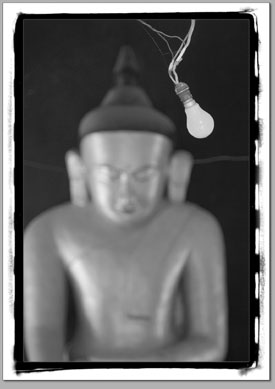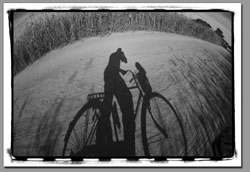| ||||
Photographing the Buddha
by Jules Masterjohn Colorado photographer Bob Winsett wasn’t looking to create a visual pun in his photograph that combines a Buddha statue with a bare light bulb hanging from the ceiling. He intended to show the statue in its natural surroundings. Yet he has done so and this insightful image is included in his show, “Buddha,” opening on Fri., May 2, at the Open Shutter Gallery. Winsett’s concerns were more formal and focused on the compositional elements in his photographs. “I was out looking for different angles, different ways to depict Buddhas in different locations. I did not want to present the usual straight-on shot,” he told me. Winsett chose the Buddhist sacred image as his subject due to his introduction to Buddhism in 2000, when he began his mediation practice and studies. This personal experience motivated him to travel to Thailand, Burma, Bhutan and India to photograph as many Buddha statues as he could wrap his lens around. From this brief pilgrimage, he has reproduced 20 small-format, digitally printed color photographs. They show Buddhas of all sizes: a giant, serene figure reclining on a bed of carved lotus, a small statue residing in an intimate wall niche surrounded by fresh flowers, golden Buddhas with finely painted features and others with their once colorful paint peeling. All are sitting, lying or standing, and each shows the figure with various hand gestures or mudras. A mudra is an important symbolic aspect to the statue, referring to the actions performed by the Buddha during his lifetime such as teaching, meditating and offering fearlessness. Each Buddha’s facial feature expresses a similar quality of peacefulness and tranquility. Winsett traveled to the temples in Bodh Gaya, the city in northeastern India that marks the site where Siddhartha Gautama attained enlightenment and became The Buddha, or “awakened one.” It was there, under the Bodhi Tree, that Gautama Buddha received the insight that life contains suffering and that suffering can cease. He dedicated his life to teaching this understanding so that all beings might be free from this condition. Dedicated as a World Historic Site by UNESCO, millions of people visit, and photograph there, every year. The photographer also spent five days in Bagan, Burma, the country currently known as Myanmar. The thousands of temples there have been dated to the 12th century, with more being recovered from the dense jungle vegetation every day. “I’d get up at sunrise, rent a bicycle that cost $3.50 a day, photograph 15 Buddhas, come back filthy dirty from road dust, and go out and do it again the next day. I had so much fun.”
In some countries, the conventions for portraying the Buddha’s image are quite strict and prescribed. In others such as Burma, there are many ways of portraying the Enlightened One. These statures are not objects to worship, they are considered to be symbolic representations of the Buddha, intended to remind and instruct as to the path of enlightenment. “I love the variations in Buddha imagery,” he offered. “Some have been restored and others have not. Nevertheless, it was interesting to me to stand before these statues and to try to imagine the culture that allowed Buddhism to flourish so widely and magnificently. With over 2,500 temples in about a 10-square-mile area, you can see an incredible testament to the importance of Buddhism at the time.” One of the qualities that Buddhism encourages is a generous heart. Winsett has demonstrated this Buddha-nature since his relationship began with Open Shutter in 2001. He gave gallery owner Margy Dudley a photograph of a young Buddhist monk standing on a street corner as a gallery-warming gift. It is the one item in the gallery’s collection that is not for sale. Dudley also uses it on the gallery’s homepage and business cards. Winsett’s work has been on view at the gallery since its doors opened. His small prints and cards bear images of bicycles, people and cultures from all around the globe. His photographs express the simple essence of the moment – two hands holding a teapot, or one resting on worn book pages – and many depict life in Buddhist countries. His vision weaves nicely with Dudley’s mission that the gallery brings the bigger world to Durango. He will be present for an artist’s reception at the gallery on Fri., May 2, from 5 - 8 p.m. It is wonderfully appropriate that his exhibit, on display through May 28, is the last show at Open Shutter’s current location. The gallery will reopen in its new location at 735 Main Ave. on June 27 with the exhibit, “Street Photography: From Classic to Contemporary,” which will feature work by Henri Cartier-Bresson and Craig Semetko. • Open Shutter is located at 755 E. Second Ave. in Durango. Gallery hours are 10 a.m.-6 p.m., Monday –Saturday.
|



